Apple iPhone 14 review: Should you upgrade this year?
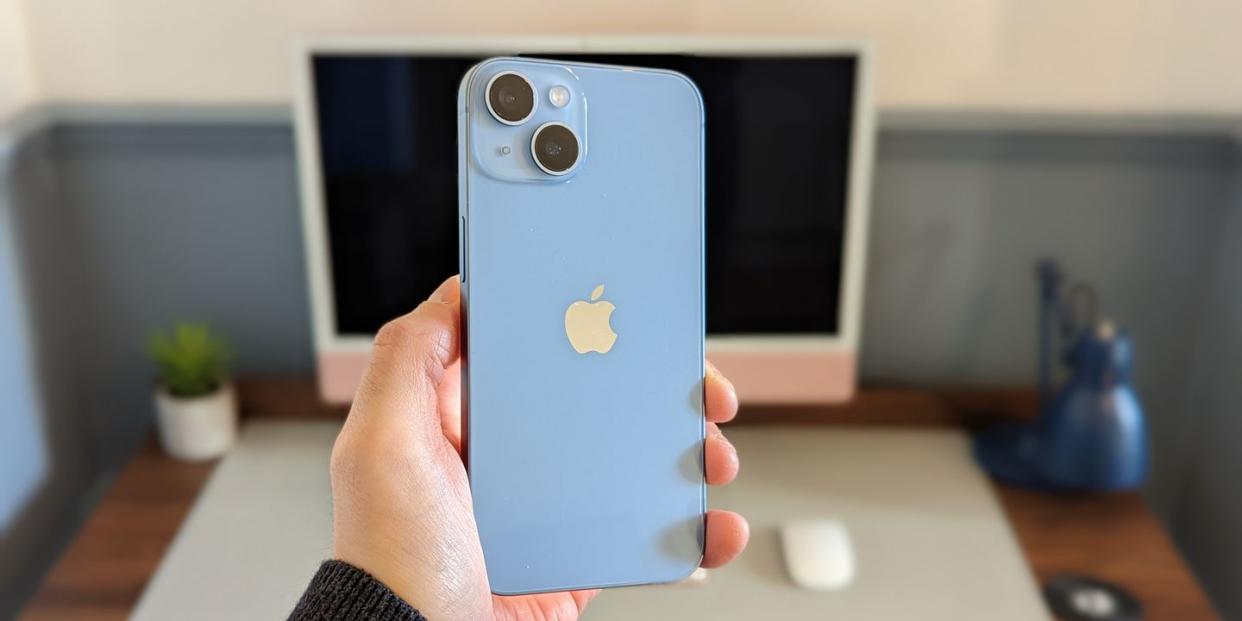
The iPhone 14 is a fantastic smartphone in almost every way. It has a great screen, speedy performance, fantastic software and some of the best cameras at this price point. It shines when paired with the Apple Watch or AirPods, and the build quality strikes a nice balance between lightweight and high-end. After testing, we reckon it’s probably the best phone that we recommend you don’t rush to buy.
Expecting a major overhaul compared to last year’s iPhone 13 series quickly leads to disappointment. There are a handful of small updates – including a video mode that increases stabilisation and a crash detection feature we hope you’ll never need – but the list of similarities with the previous flagship is much longer – including the screen size, processor, water resistance rating, megapixel count and design.
Should you upgrade? Anyone with an iPhone 13 (or even an iPhone 12) isn’t missing much by not snapping up the latest model. Anyone who is coming from an older iPhone – or making the switch from Android to iOS for the first time – will find a lot to love, although we reckon the iPhone 14 Pro is a better option if you’re able to stretch the budget due to its better cameras, processor and the cool new “Dynamic Island”. Love big screens? You may want to check out the huge 6.7-inch iPhone 14 Plus.
iPhone 14 key specs
• Screen size: 6.1‑inch
• Resolution: 2532 x 1170 pixels
• Operating system: iOS 16
• Processor: A15 Bionic
• Cameras: 12MP main, 12MP ultra-wide
• Battery life: Up to 20 hours
• Storage: 128GB, 256GB, 512GB
• RAM: 6GB
• Weight: 172g
• Water resistance: Yes, IP68
• Micro SD card slot: No
iPhone 14 design
There’s no argument from us, the iPhone 14 is a lovely-looking smartphone – in the same way as its last two predecessors. Like the spec sheet, little has changed in the looks department and most people will struggle to tell the difference at a glance.
Still, the aluminium/glass build quality feels worthy of the price (although it’s £100 more in the UK this year) and the handset is sturdy yet lightweight, while the buttons have a pleasing clickiness when pressed. The notch remains, and we can’t help but feel that it’s a shame the new Dynamic Island tech that lets iOS apps use this space for alerts and notifications isn’t in the base model. For that, you have to go Pro.
We tested the blue version and have no complaints about the colour – it looks very vibrant and stands out when compared to the Pixel 6 we were previously using as our daily driver.
It also comes in purple, black (midnight), white (starlight) and red, although you’ll want to invest in a quality case to protect the glass against scratches or bumps. While the sizes are almost identical, the new phone is just slightly thicker than the prior model, so be warned that cases for the 13 won’t fit perfectly.
We like the button layout overall – with the volume on the left side and power on the right – and like the other iPhones with the same design, it feels natural to hold and use with the gesture controls. However, it’s way past time that Apple embraces USB-C on its phones instead of Lighting for the charging port at the bottom.
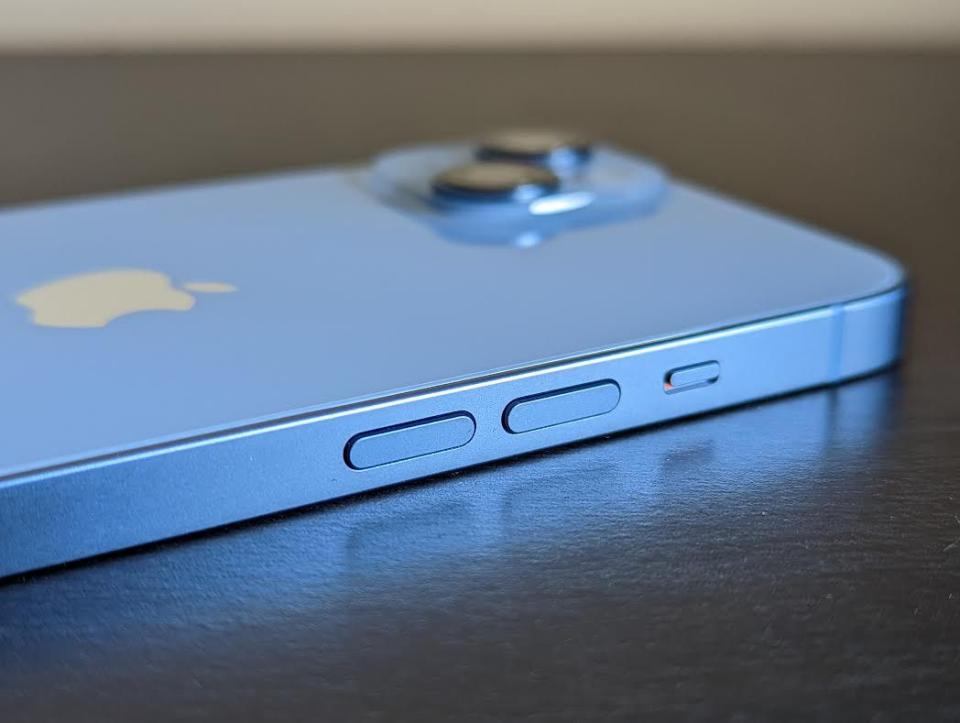
iPhone 14 camera
The iPhone 14’s dual-camera setup (12MP wide, 12MP ultra-wide) has been slightly enhanced this year with the addition of Apple’s “Photonic Engine” – which is a fancy way of saying it uses software smarts to make your photos look better, especially in lower light. It’s not a massive overhaul, but this is still one of the best options you have for getting quality images from a smartphone. Just point and shoot.
We tested the cameras alongside an iPhone 14 Pro and last year’s iPhone 13 Mini (there’s sadly no new mini model this year) at London’s Trafalgar Square and found the results to be surprisingly similar – although the 14 Pro easily wins as an overall package for any keen photographers due to its larger 48MP sensor that lets you shoot in raw format (ideal for photo editing), plus a significantly better zoom (not to mention better processing due to the A16 Bionic chip).
Still, we found the iPhone 14 to be more than capable. In slightly overcast conditions, shadows looked great cast across the grey construction of The National Gallery, and turning to Nelson's Column we captured the afternoon sun reflecting off puddles on the ground with storm clouds in the distance. A morning shot at a train station caught the bright sky and piercing sun without being overexposed, and colours remained accurate in lower lighting in one shot taken just as the sun was going down.
Here are examples of the types of photos you can expect from the iPhone 14 lenses. These are taken straight from the camera, with no re-touching or editing.
While anyone with an iPhone 13 won’t be shocked by the camera performance (it’s effectively the same) we appreciate that when using portrait mode, the iPhone 14 cameras can now blur objects in the foreground as well as the background in pictures. While the front lens is still 12 MP, it’s nice to see that it now has autofocus and a wider aperture (f/1.9 instead of f/2.2) that lets in more light in, too.
Unlike the previous iPhone, Apple has brought “action mode” to the video settings – and we found this effectively smoothes motion when walking. It will be a big deal for anyone who uses the phone for filming videos for YouTube or social media and the ultra-silky footage is one sure-fire way to make your Instagram followers jealous, but we admit that it’s not a feature we would use too much during our typical day.
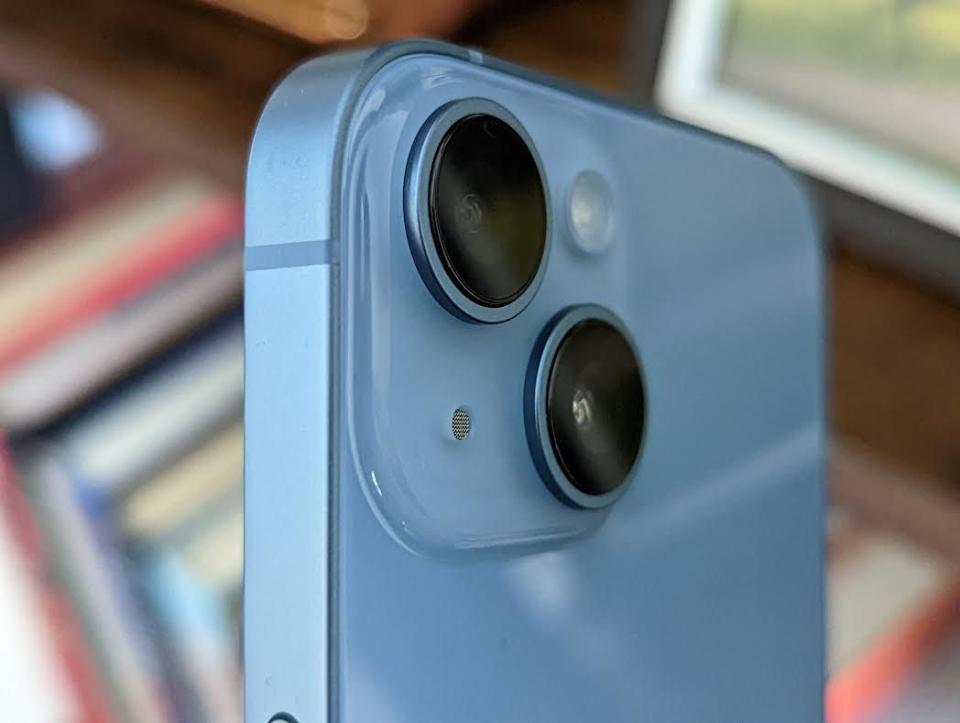
iPhone 14 software
The iPhone 14 comes with the latest iOS 16, and this does more to make the phone feel new than any hardware specs. It’s a joy to use. Lock screens have more customisation than ever, letting you add widgets such as weather, news, a calendar, fitness or reminders – plus change the font and colour of the clock face.
We enjoy being able to prominently show the real-time battery life of other connected devices, such as the new AirPods Pro, with a large widget, and the enhanced focus modes let you silence notifications from specific apps or individual contacts.
Of course, iOS 16 isn’t unique to the iPhone 14. It’s also coming to earlier iPhones, and because this base model is running the same A15 chip you’re unlikely to get any performance boost by having the latest model. What is new for the 14 line-up is the Crash Detection that instantly calls for help if you get into a car accident. For obvious reasons, we haven't put this to the test and we hope you never have to use it.
iPhone 14 battery
Unlike some Android handsets these days, the iPhone 14’s battery life won’t last for multiple days from a single charge. Using the handset moderately during the day – watching videos from YouTube and listening to music via Spotify during a commute of around two hours total, as well as checking social media and emails – we were usually able to get a little over one full day before needing to power up.
Like the iPhone 13, the iPhone 14 supports MagSafe (up to 15W) and Qi wireless via portable chargers (up to 7.5W). You’ll get around 50% of charge in roughly half an hour using a 20W wall adapter, and while that isn’t in the box you can buy one of the best iPhone chargers for under £20.
The use of a Lightning Connector to charge the handset feels outdated, and we wish Apple would embrace the UCB-C life like it has done on its MacBooks and iPads. Maybe next year.
iPhone 14 display
Colours and contrast pop on the iPhone 14’s 6.1-inch OLED panel. However, the display hasn’t changed from last year’s model, with the same resolution, adaptive brightness and nice haptic feedback.
It’s all still brilliant, of course, but it’s not new. As has been the case for the previous few iPhones, Apple is sticking to a 60Hz refresh rate on this model and it’s a little awkward when so many competitors offer up to 90Hz – which allows for much smoother scrolling and performance – as a minimum.
Luckily, you’re unlikely to notice much of a difference unless you directly compare the iPhone 14 with the iPhone Pro side-by-side, and we quickly got used to downgrading from the higher refresh rate of the Pixel 6, so it’s not a dealbreaker.
The borders around the display are small and inoffensive, although the notch on the screen is still a bit too large for our liking – especially when it’s effectively wasted space. In our head, we know Pro users are relaxing on their Dynamic Island and enjoying an always-on display, making the base 14 feel instantly outdated.
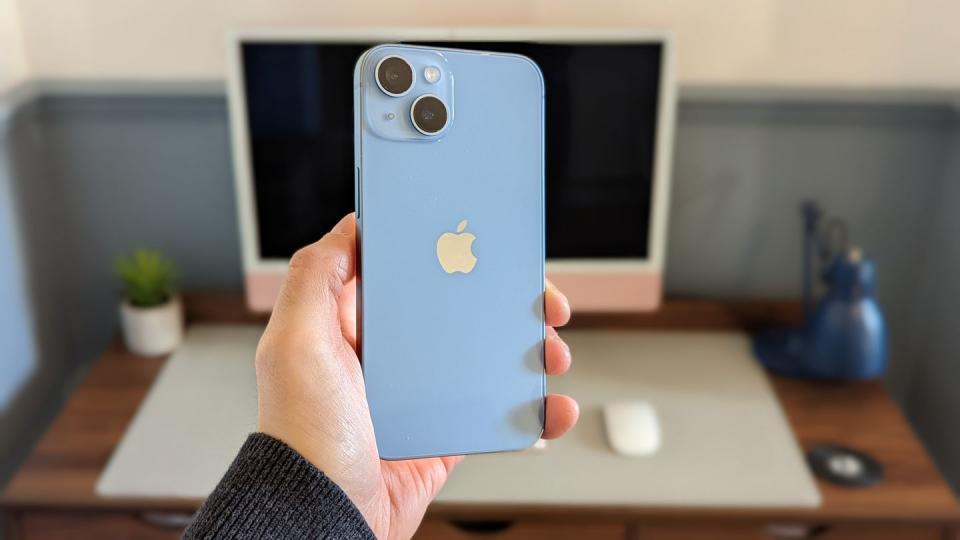
iPhone 14 performance
Unlike the last few iterations of the iPhone, the 14 doesn’t have the same chip as the Pro models. The base model has the same A15 Bionic processor as the iPhone 13, while the Pro models have jumped to A16.
Honestly, for day-to-day use it’s fine – and we had no issues with performance when downloading and running apps, browsing the internet, listening to music, watching videos or swiping through menus.
On a home wifi connection, Mario Kart Tour and Angry Birds 2 downloaded in around 30 seconds (the larger-sized Call of Duty: Mobile took a few minutes) and they ran smoothly and lag-free when playing.
We didn’t have issues with overheating either, which we encountered when trying out the Google Pixel 6a. If you have the right data plan, the iPhone 14 has 5G connectivity for ultra-fast downloads.
Face ID is fast and responsive, and while we don’t plan on taking the handset into the shower it has an IP68 water resistance rating, which means it can theoretically survive submersion up to 1.5m for up to 30 minutes. We tested the 512GB model, but like the iPhone 13 there are also options to get 128GB or 256GB of built-in storage.
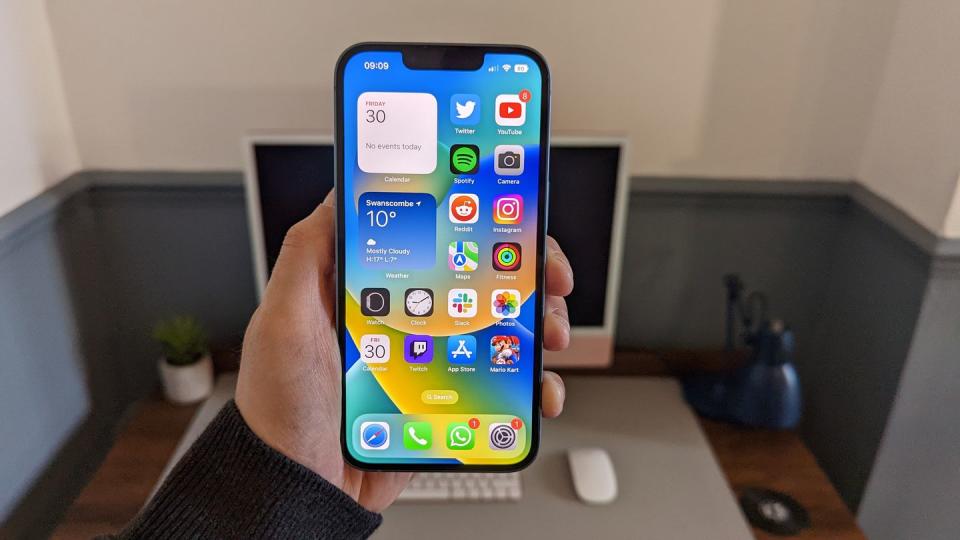
iPhone 14 drawbacks
While the standard iPhone 14 feels like a feature-rich and high-end smartphone, we don’t love that the UK entry-level pricing has increased by £100 in the UK this year, going from £749 to £849 for the 128GB model.
We are not sure that it does enough to justify that increase, especially as it has the same chip as the 2021 phone. The specs remain impressive, but we also think it’s time this model got a higher refresh rate and USB-C charging. There’s no escaping that Lightning cable just yet.
iPhone 14 verdict
The iPhone 14 is the best smartphone you don’t need. It’s brilliant in almost every way, but it’s the definition of incremental update.
Anyone with an iPhone 13 is likely to be happy getting iOS 16 and waiting until next year when we could see a bigger overhaul of the design or processor. And due to the similarities with last year’s phone (which is still available) will anyone really want to spend the extra £100 for the latest one?
Users of the older iPhone XR or iPhone 11 may be looking to upgrade, but they can also save some money by going for the iPhone 13 or the new iPhone SE. If you can get a great iPhone 14 contract deal and want a model from the latest line-up you won’t be disappointed, but if you can afford the extra £250 we recommend checking out the iPhone 14 Pro as it gives you better features, cameras and battery life.
You Might Also Like

